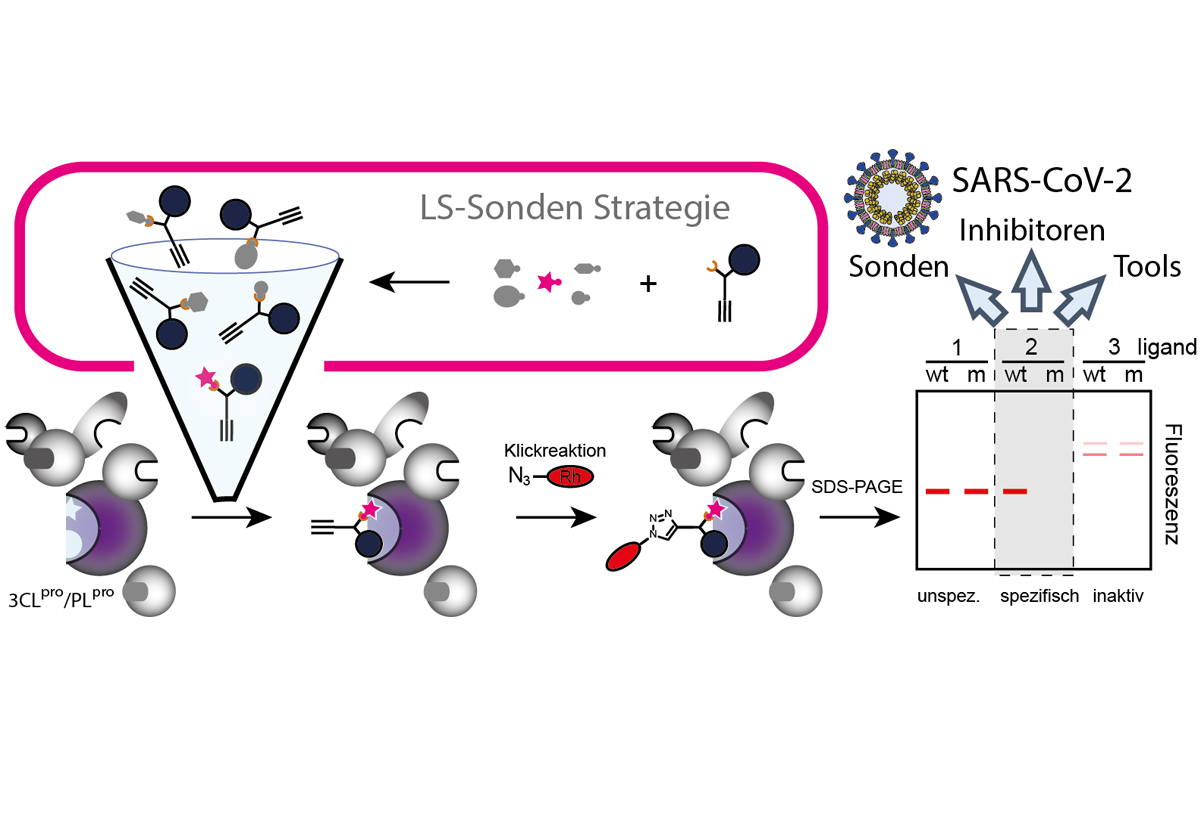![[Translate to Englisch:] [Translate to Englisch:]](/fileadmin/pi/fileserver/2021/Chemische_Sonden_Suche_nach_Wirkstoffen_Coronavirus.jpg)
Chemical probes help to search for agents against Coronavirus
Research team in the Departments of Chemistry at the University of Konstanz and the University of Vienna developed a method to find potential agents against the replication of the coronavirus in human cells
Currently, the world is not only searching for effective vaccines, but also for therapeutic options to treat SARS-CoV-2 infections. The efforts target on enzymes that are essential for the replication of the virus in human cells. Led by the research team around Professor Thomas Böttcher, Department of Chemistry at the University of Konstanz and the University of Vienna, researchers now succeeded in developing a chemical tool to find new inhibitors for the two essential proteases of the new coronavirus. The tool may not only be used to answer basic research questions and detect enzymes in complex samples, but also to screen for drugs against the coronavirus. The results of the study have been published online in the international issue of the journal Angewandte Chemie of the German Chemical Society (GDCh).
Proteases are enzymes and may be compared to molecular scissors that cut other proteins, usually at exactly defined points. The coronavirus needs them to be able to replicate in human cells. The active site of these enzymes corresponds to the blades of a pair of scissors. If the blades are blocked, the enzyme can no longer cut and thus not fulfil its role in the virus’s replication. “We developed chemical probes that bind precisely to the active site of the two proteases Mpro and PLpro and thus selectively prevent the molecular scissors from cutting”, explains Thomas Böttcher.
Probe can be used to find agents against the virus
The binding of the probes to the active site of an enzyme can be made visible with a fluorescent dye. The fluorescence signal indicates whether the enzyme is present and, more importantly, whether the active site is accessible. If an inhibitor blocks the active site, the probe cannot bind and there will be no fluorescence signal. The probe can thus be used as a diagnostic tool in research or to find agents against the virus.
For a probe to bind selectively to the active sites of proteases, fine-tuning of its chemical structure is necessary. A new strategy that allows creating tailor-made probes for a specific enzyme made this optimization possible. Doctoral researcher Lilian Peñalver in the research unit of Thomas Böttcher developed this strategy and applied it to SARS-CoV-2 proteases, supported by collaboration partners at the University of Konstanz.
Protease inhibition prior to activation could bring decisive advantages
When someone is infected, the virus introduces its genetic information into human cells, causing them to read the genetic information and produce proteins according to its instructions. The proteases are responsible for the maturation of the proteins produced. However, the proteases are hardly active at the beginning and must first activate themselves and “cut themselves free” from a long protein chain. “So far, it was only possible to study the already activated form of the protease. Our method is unique in that we can also use the probes to target the form that has not yet been activated,” explains Thomas Böttcher. The probe strategy could help to find exactly those active substances that inhibit both forms of the protease at the same time. Inhibiting a protease before it is fully activated could provide critical advantages for a future drug against the new coronavirus and effectively prevent the virus from replicating.
In a feasibility study, the team screened a library of compounds that might be suitable for inhibiting the two proteases of the coronavirus. They selected substances already approved for use in humans, which has the advantage that they are safe and directly therapeutically applicable. The library included mainly plant ingredients that are used as dietary supplements or in other ways. With the help of the probe strategy, the researchers indeed found promising molecules, in particular substances from red sage.
Thomas Böttcher's team was thus able to demonstrate the effectiveness of their process in the test tube. Now further studies will have to show whether it also leads to success in human cells and ultimately in humans. However, even if the substances from red sage do not prove to be successful candidates, the new probe strategy is a valuable tool for detecting further drug candidates. “We have shown in our study that there are natural products that are highly active against the proteases and that our method makes it very easy to find them,” says Thomas Böttcher.
Key facts:
- Original publication: Lilian Peñalver, Philipp Schmid, Dávid Szamosvári, Stefan Schildknecht, Christoph Globisch, Kevin Sawade, Christine Peter, Thomas Böttcher (2020). A ligand selection strategy identifies chemical probes targeting the proteases of SARS‐CoV‐2. https://doi.org/10.1002/anie.202016113
- Led by Professor Thomas Böttcher, a research team in the Departments of Chemistry at the University of Konstanz and the University of Vienna developed a method to find potential agents against the replication of the coronavirus in human cells
- Method provides the option of discovering entirely new agents that inhibit both the active form of protease and the protease prior to activation, and which might be used in new drugs.
- Project funding from the Emmy Noether Programme of the German Research Foundation (DFG) and the Collaborative Research Centre “Chemical and Biological Principles of Cellular Proteostasis” (SFB 969) at the University of Konstanz.

